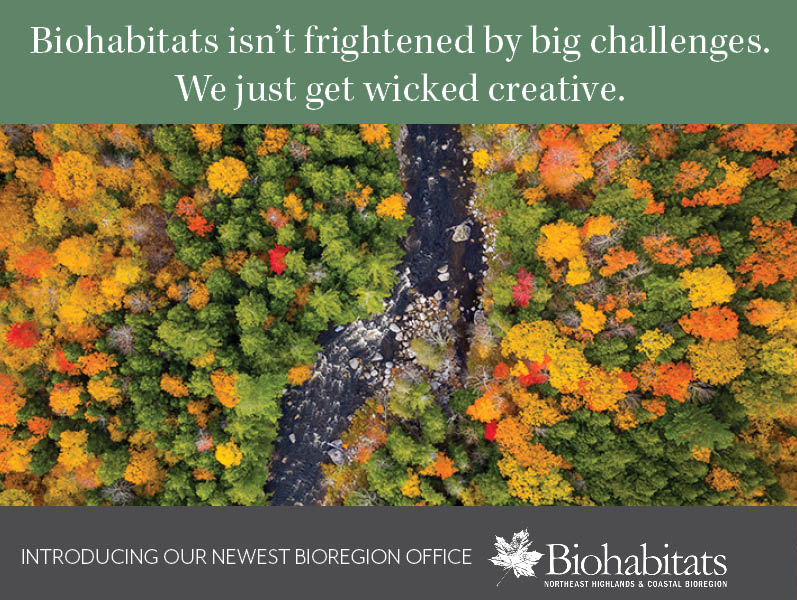Biohabitats Projects, Places and People
By Amy Nelson
News
Biohabitats opens new office to bring more nature-based solutions to New England region
Earlier this year, to better serve clients throughout the New England region, we established a Northeast Highlands and Coastal Bioregion office in Glastonbury, Connecticut. Led by fisheries and water resources engineer and dam removal expert, Laura Wildman, the new office offers ecological assessment, planning, design, engineering, design-build, construction management, and monitoring services to help communities in New England restore ecosystems, conserve habitat, and regenerate life-sustaining natural systems.
Making Waves (Soundwaves, that is)
Biohabitats is thrilled to be sponsoring six episodes of the Rewilding Earth podcast in 2022. Produced by the Rewilding Institute and hosted by Jack Humphrey, the podcast highlights the work of the people involved in saving nature’s building blocks, whether they be intact wilderness or key corridors and buffers surrounding wilderness, as well as people invested in protecting and reintroducing extirpated species to these areas. Guests include conservation biologists, activists, naturalists, organizers, artists, and authors. Our first sponsored episode will air in April, and it will feature Cara Nelson, Professor of Restoration Ecology; Chair, Department of Ecosystem and Conservation Sciences at the University of Montanta’s W.A. Franke College of Forestry & Conservation. We’ll share more about that soon on our website and social media platforms!
Projects
Nature-Based Solutions Being Implemented in South Carolina’s Low Country
Before it was altered by rice cultivation and phosphate mining, the landscape surrounding South Carolina’s Church Creek was a low-lying, forested wetland that was frequently inundated by storms and influenced by tides. Enter the intense suburban development of the 1970s and 80s, and you’re left with a frequently flooded basin with diminished ecological value, further disrupted by vulnerable, low-lying human communities.
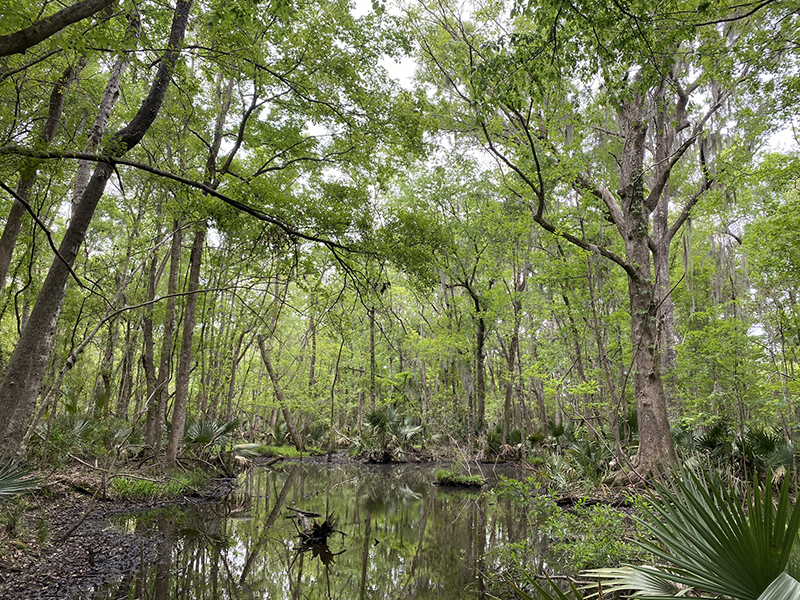
For the past year, we’ve been working with the City of Charleston to identify and prioritize opportunities to use green infrastructure and other nature-based solutions to alleviate flooding and enhance the ecology within the 5,000-acre Church Creek Basin. The intention will seek to build more resilience from future flooding while providing new recreational opportunities for its human communities. We are excited to report that the first of those opportunities, property that was formally three home sites, is currently being transformed into a wetland storage system and parklet within a residential community. The project is advertised for bidding, and construction is slated for late spring 2022. The site is the first of four progressively larger nature-based design projects which will culminate in more than twenty acres of emergent and forested wetlands. Unlike traditional infrastructure which degrades as the years pass, nature-based solutions are designed to get stronger and more robust over time. We look forward to seeing these solutions bring benefits to the people and wildlife of the Church Creek Basin. For more information, please contact Chris Streb.
Former Farm Fields Yield Ecological Bounty
In the early 1900s, wetlands that once dominated western Ohio’s Blanchard River watershed were drained and converted to croplands, and the river itself was altered to support agriculture. Fast forward a century or so and you have a river system severely impaired by siltation, low oxygen, and excess nutrients and ammonia. But things are changing for the better along the Blanchard. Last month, we wrapped construction on an H2Ohio-funded project that is restoring 74 acres of former cropland to a mosaic of seasonally inundated floodplain wetlands and forested riparian habitat augmented with large woody debris habitat features.

To design the restoration, we collaborated with the Maumee Watershed Conservancy District, the Village of Ottawa, Ohio DNR, Ohio Lake Erie Commission, and Putnam County SWCD. This restoration project makes use of the hummock and hollow topography along with seepage berms to maximize floodwater retention, nutrient assimilation, and sediment capture. For more information, please contact Kevin Grieser.
Aurora, Colorado Floats a New Idea for Improving Water Quality
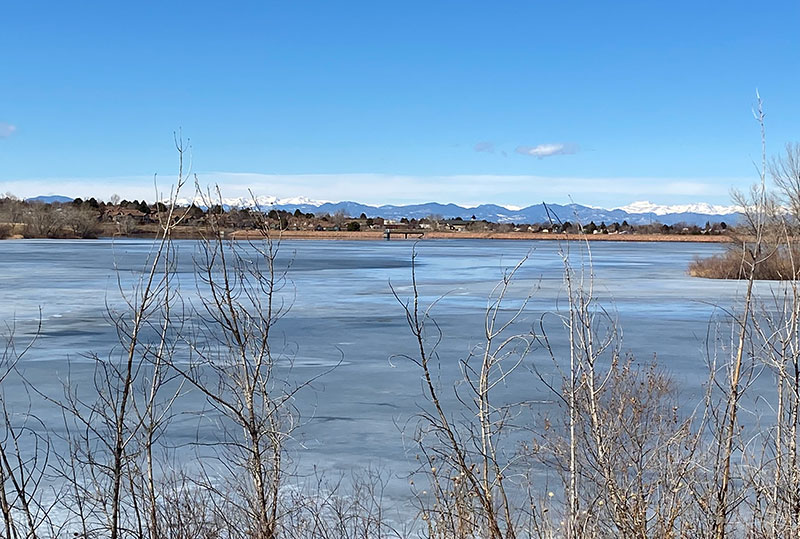
As part of a team led by Hazen-Sawyer, we are working with the City of Aurora to take a novel approach to water quality at Quincy Reservoir, a major (160-acre) water supply. Using a combination of hydroponic floating wetlands (hydroponic indicating that there will be no soil) and wetlands planted along the shoreline, strategies to meet water quality standards will include allelopathy (the chemical inhibition of algae and cyanobacteria by selected wetland plant species) and nutrient sequestration.
Freshwater Wetlands Enliven a Rescued Landscape in New Jersey
If you were to travel back in time to the early 2000s and visit what is now Teaneck Creek Park, it is hard to say which features might have made the strongest impression: the mountainous heaps of debris or the deeply eroded gully known as “Stormwater Canyon.” Located across the Hudson River from upper Manhattan in the town of Teaneck, New Jersey, the land was once dominated by tidal wetlands. After the installation of a downstream tide gate and decades of use as a staging ground for interstate highway construction, the site became degraded by dumping and hydrological alteration. Thankfully, a group of dedicated community members and environmentalists worked with the County to develop a plan to restore the site and transform it into a public park. Integral to the transformation was the creation of freshwater wetlands. Building upon a concept created by Rutgers’ Center for Urban Environmental Sustainability,
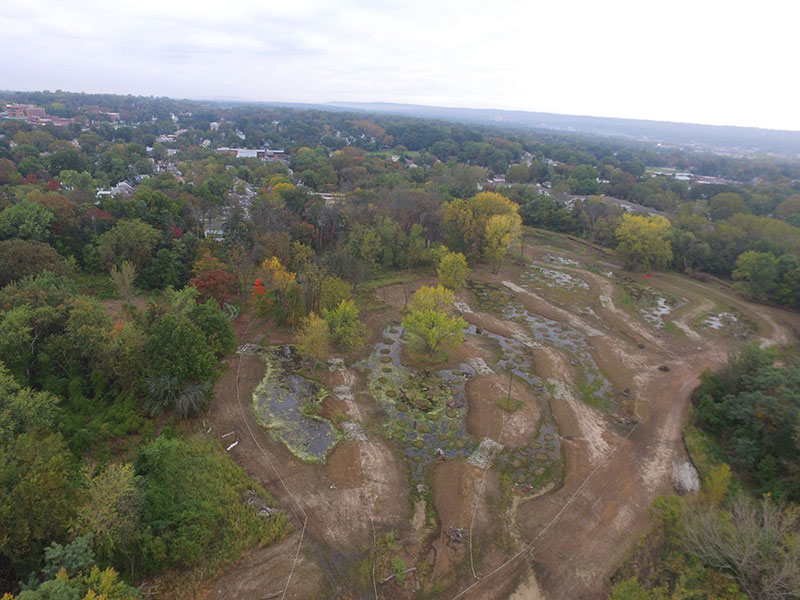
Biohabitats developed a design that uses the site’s existing topography and hydrology to retain and treat water before it enters Teaneck Creek. The design focuses on restoring wetlands within the creek’s floodplain and mitigating the erosive forces of stormwater through regenerative design. We are thrilled to report that the design has been implemented. Construction, which was conducted by SumCo Eco Contracting and managed by SiteWorks wrapped earthwork operations in the fall of 2021, and planting is scheduled for spring 2022.
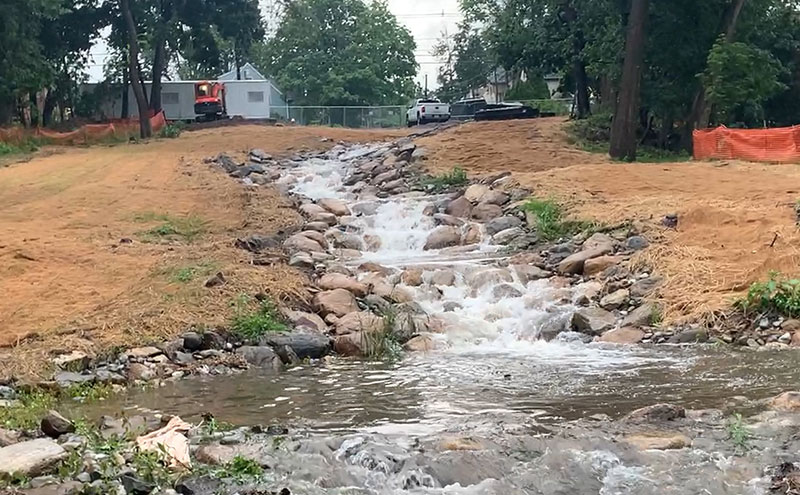
When the park reopens, instead of Stormwater Canyon and ridges of refuse, visitors to Teaneck Park can look forward to seeing the wonders of a functioning creek and freshwater wetland system. For more information about this project, please contact Kevin Dahms.
Straightening out the Ecology of a Straightened Creek
Chicken Creek once wound its way to the Tualatin River along a curvy course through what is now the Tualatin River National Wildlife Refuge. A century ago, the creek was straightened to support agriculture and became a half-mile-long ditch. Working with Clean Water Services, the U.S. Fish and Wildlife Service, and other project partners, we restored Chicken Creek’s natural curved flow through the Refuge.
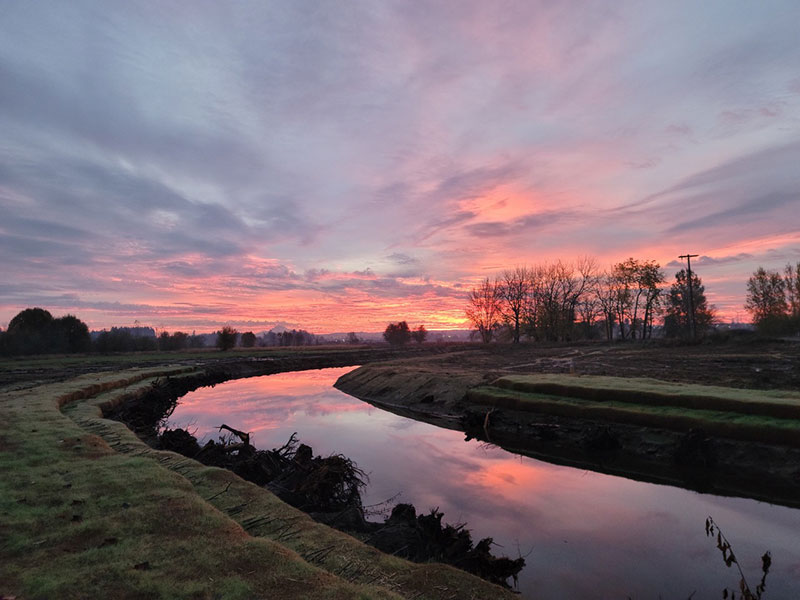
The restoration transformed the straightened ditch into a winding, two-mile channel and regenerated nearly 300 acres of functioning floodplain and wetlands. The project involved installing over 50 large wood floodplain habitat structures, and 1200 LF of engineered soil lifts with toe logs and rootwads. The final component of construction involved installing 25,000 native trees and shrubs and 12,000 live stakes earlier this month.
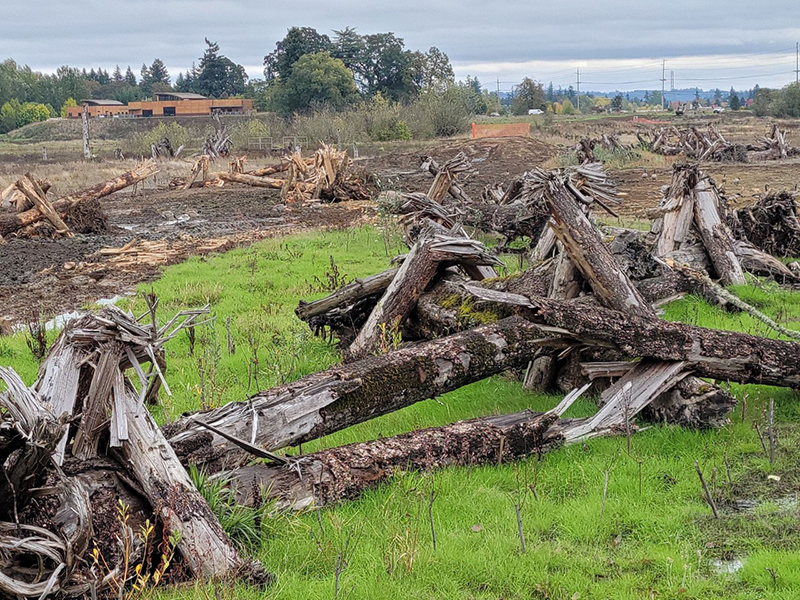
These woody debris structures, which are meant to mimic the way tree debris naturally enters and settles in steam and wetlands systems, will work in tandem with anticipated beaver activity to help spread water out to the floodplain while providing habitat for a diversity of fish, aquatic insects, and other native wildlife. The restoration also provides new opportunities for people experience the Refuge and the creek by hiking and birdwatching. For more information about this project, please contact Matt Koozer.
Connecting Farms and Forests: Musser Gap to Valleylands at Pennsylvania State University
Our team recently wrapped up work on Penn State’s Musser Gap to Valleylands (MG2V) project. Biohabitats led an interdisciplinary design team that included Andropogon Associates and NTM Engineering to consider everything from circulation and trail amenities to stormwater management and integrated ecological function. Our team developed a detailed phasing and costing plan to support the future implementation of a series of trails weaving through active farmland and new areas of ecological restoration and open space across 355 acres of land that connects State College to Rothrock State Forest on the outskirts of town.
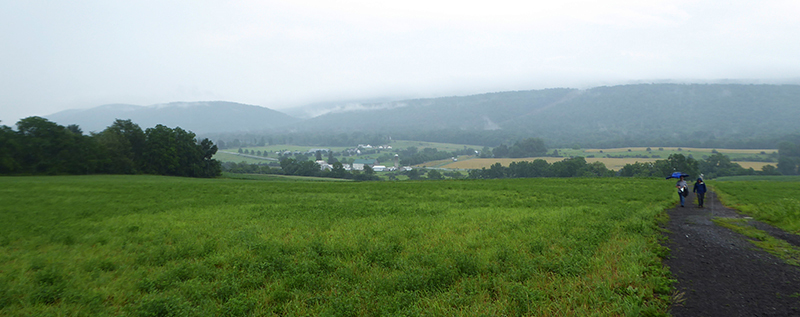
Over the last eight months, we have enjoyed our collaboration with a diverse group of Penn State faculty, staff, and local stakeholders. Our work grew from several years of detailed baseline analysis, community outreach, and conceptual design work conducted by faculty and students in the Department of Landscape Architecture within the Stuckeman School in the College of Arts and Architecture and the local non-profit, the ClearWater Conservancy. We look forward to seeing the MG2V plan come to life in the coming years! For more information about this project, please contact Jennifer Dowdell.
Good News for Fish in Boulder County, Colorado
We recently completed an alternatives analysis for fish passage options on two diversion structures on Left Hand Creek in Boulder County, Colorado. The Haldi Diversion is operated by the Left Hand Water District and is used for drinking water. The Left Hand Valley Diversion is operated by the Left Hand Ditch Company and is used for agricultural irrigation. The Haldi structure is about 10’ tall and the Left Hand Valley structure is about 4’ high. Both structures block fish passage, and they often divert all of the water from the creek. In an effort to determine the feasibility of providing both fish passage and environmental flow through these diversions, the Left Hand Watershed Center hired Biohabitats with support from Wright Water Engineers and GEI to develop conceptual fish passage designs and investigate water rights and flows in Left Hand Creek. Based on our assessment of site constraints and opportunities along with several meetings with stakeholders to understand their operation needs and concerns, we developed two improvement concepts for each diversion.
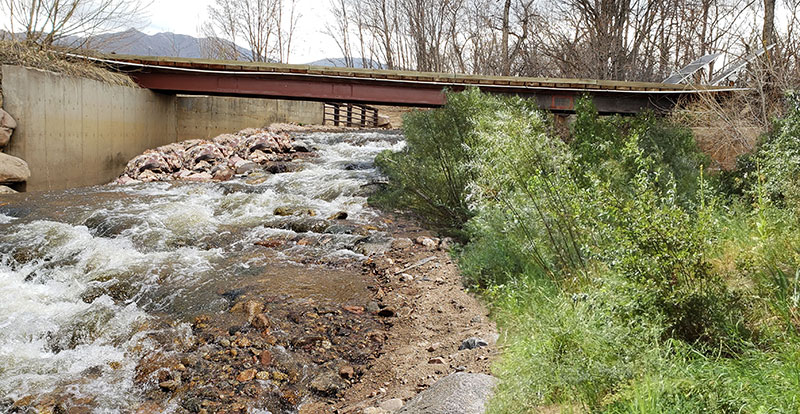
These concepts provide sound approaches to improving the maintenance of sediment accumulation at the diversions as well as fish passage. Our flow study indicates that there are options to providing environmental flows in the creek when conditions are appropriate. For more information about this project, please contact Vince Sortman.
Strict Permitting Yields Win-Win in Chesapeake Bay Watershed
When your populous county is located adjacent to the nation’s largest estuary, you can expect stringent permit requirements when it comes to pollution. That is the case for Anne Arundel County, Maryland, which is bordered to the east by the Chesapeake Bay. To help the County comply with stringent NPDES and MS4 permit requirements while also improving local ecology, we collaborated to restore Beards Creek, a degraded and actively headcutting incised tributary to the South River, and ultimately the Bay. Working with the County and the Arundel Rivers Federation, we created a solution to reconnect the stream to its floodplain.
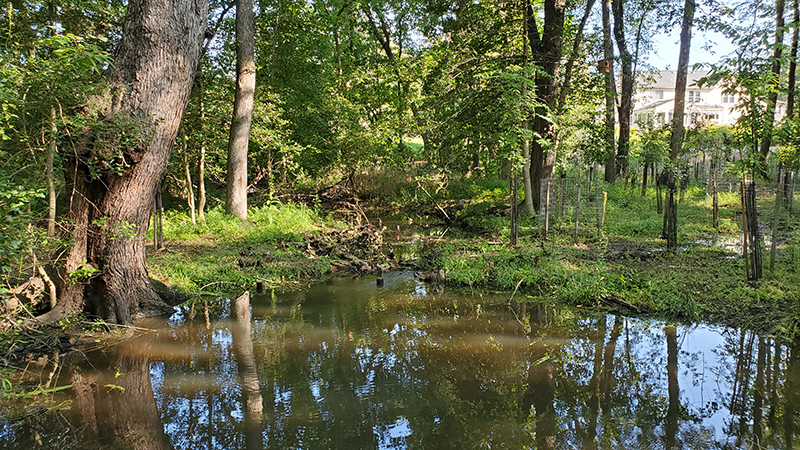
Channel-spanning engineered log jams hold the normal baseflow water surface just below the floodplain. The use of wood, the dominant form of natural grade control in the Coastal Plain, results in a resilient, nature-based, and relatively low-carbon footprint solution for restoring stream and wetland health. Turning to the beaver for inspiration, we installed willow wattles across the floodplain to trap out-of-bank flows and further improve valley bottom habitat. The restoration not only enhances the stream’s long-term stability and restores function to its wetlands; it helps detain and filter polluted stormwater that would otherwise flow directly into the South River and the Chesapeake Bay.
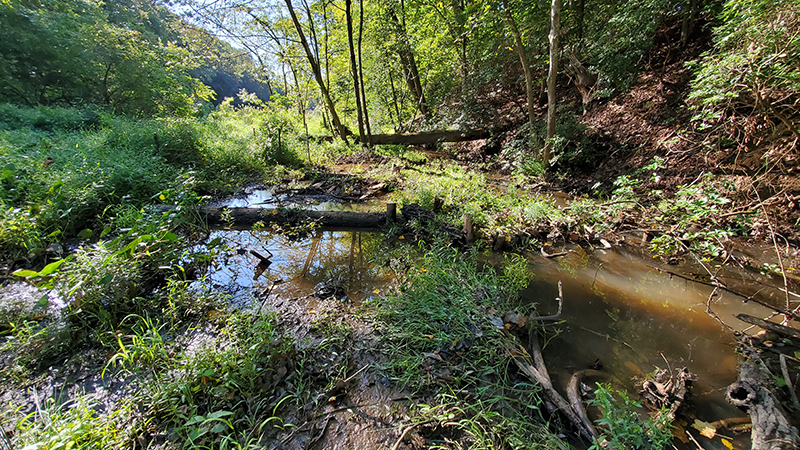
The second project involved restoring Susans Branch East, another stream that ultimately flows to the South River. Three outfalls deliver stormwater from surrounding residential development directly into Susans Branch East, and until this restoration project, that stormwater was wreaking havoc on the vulnerable, native Coastal Plain soils of the stream’s riparian corridor. The stream had become disconnected from its floodplain and severely incised, with banks up to four feet tall.
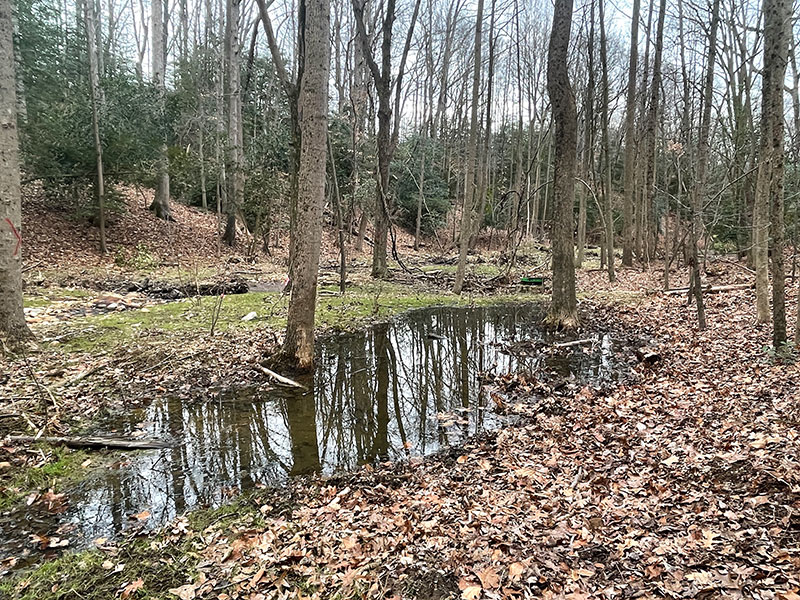
We collaborated with the County on a design approach that created a baseflow channel by raising the stream bed to provide floodplain reconnection and stable confluences with contributing stormwater outfalls. Construction, which was implemented by our friends at Underwood and Associates, wrapped last month and we look forward to watching stability, habitat, and resilience return to Susans Branch East and its floodplain wetlands! For more information about these projects, please contact Doug Streaker or Jim Cooper
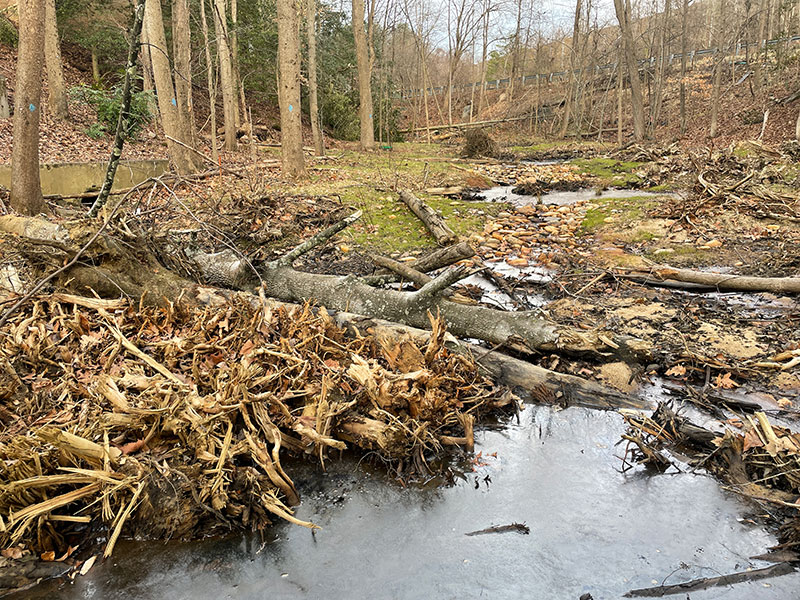
Disconnected floodplain? How about an Alternative?
Clackamas County, Oregon’s Water Environment Services (WES) operates a large, regional detention facility at the confluence of Mt. Scott, Phillips, and Dean Creeks. Known as the 3 Creeks Natural Area, it includes a complex of wetlands, uplands, and open space areas. The facility consists of an active flow control gate system and a large passive storage pool behind the control gates that can fill during large rainfall events. This pool, when full, can inundate much of the site along Mt. Scott Creek. The creek channel is highly degraded with eroding banks. We recently completed an alternatives analysis for restoring Mt. Scott Creek. Working as a subconsultant to Parametrix, we developed three restoration concepts. After discussing the concepts with WES staff and receiving input from the community, we finalized a preferred restoration option. This concept will keep the existing channel in place but raise the channel invert 6–7 feet using a combination of cobble and large wood riffle structures.
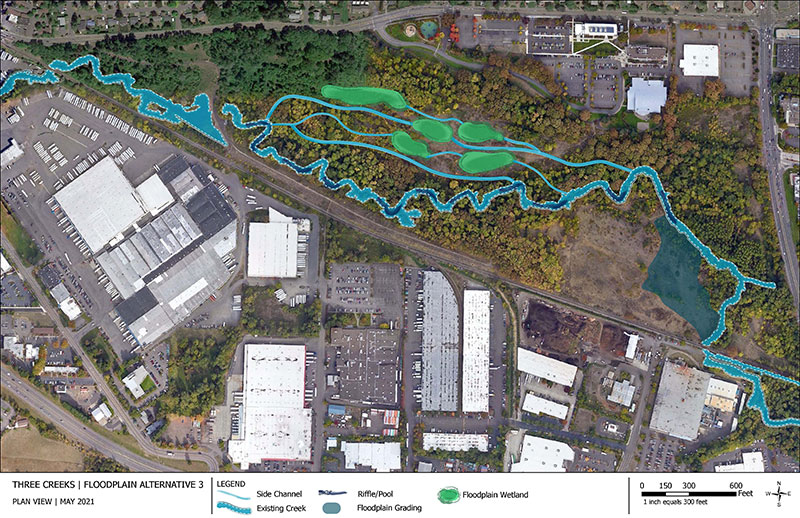
This approach will minimize disturbance to mature trees in the riparian corridor, create secondary channels and floodplain wetlands in existing open fields. It will also help spread flows throughout the floodplain, which will provide diverse hydrologic conditions to sustain a wide variety of native vegetation. The combination of frequent flooding and attenuation of water on a densely vegetated floodplain will provide water quality improvements to this highly developed watershed.
Strengthening Ecology and Community-level Resilience Along a Long-neglected Waterfront
The mouth of the Patapsco River forms Baltimore’s Inner Harbor, a vibrant waterfront that is celebrated as a jewel of the City. The Patapsco’s Middle Branch, however, is another story. Separated from the Inner Harbor by less than one mile in some places, the waterway and the neighborhoods through which it flows have suffered a long history of heavy industry, aging infrastructure, and fragmentation. Thankfully, however, the 11-mile waterfront of the Middle Branch is being reimagined in a collaborative effort involving the City of Baltimore, the South Baltimore Gateway Partnership, the people of South Baltimore, and a planning team led by James Corner Field Operations. Biohabitats is the team’s ecological consultant. Through vast stakeholder engagement, we learned that a primary community need and want is improved water quality and ecology. New recreational, educational, and economic opportunities were also identified as desired outcomes that will contribute to better health and quality of life.
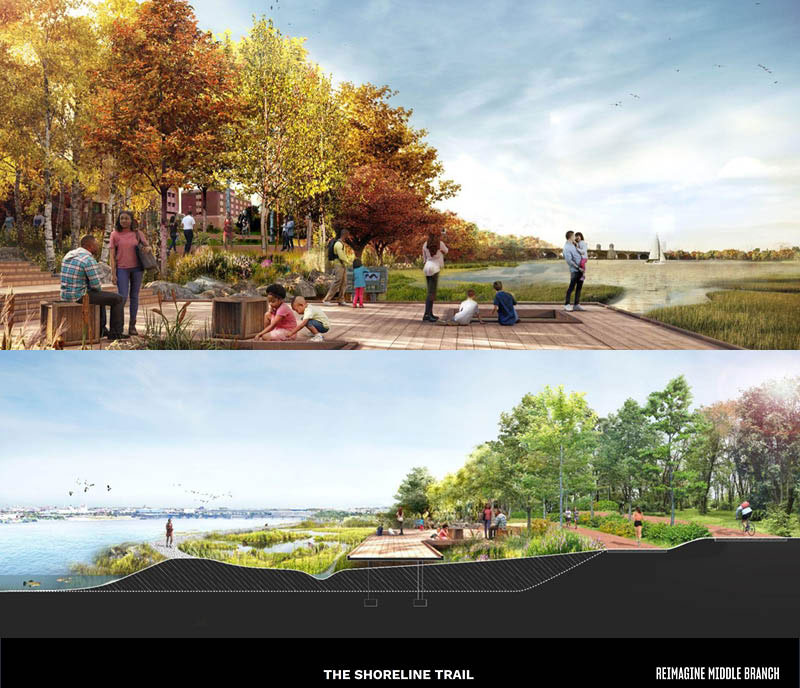
Our work has informed the plan’s ecological framework, will include enhanced forest buffer and rich, new, intertidal marsh habitat along the shore. The plan, Reimagine Middle Branch, is now public. It not only charts the course for transforming the Middle Branch into a healthy river; but also for connecting 19 South Baltimore neighborhoods—many of which have historically been underserved and subject to environmental injustice—to each other and with a vibrant and resilient waterfront. For more information, please contact Chris Streb.
Botanical Garden Demonstrates Ecological Restoration in its Own Backyard
A degraded stream on the grounds of the Lewis Ginter Botanical Garden in Henrico, Virginia is about to become one of the public garden’s major features, where visitors can learn about ecological restoration, water quality, and plants native to the region. Runoff from surrounding development had transformed the stream into an eroded gully with little habitat or ecological function. Since 2016, we have worked with Garden staff to develop a concept that would not only restore the stream but also allow it to function as a hyporheic stormwater treatment system and a living laboratory for visitors. The design realigns and reduces the size of the channel to allow frequent connection with a newly created floodplain wetland and will include a garden featuring native floodplain and wetland plants. We then helped the Garden pursue grant funding to advance the project into construction.
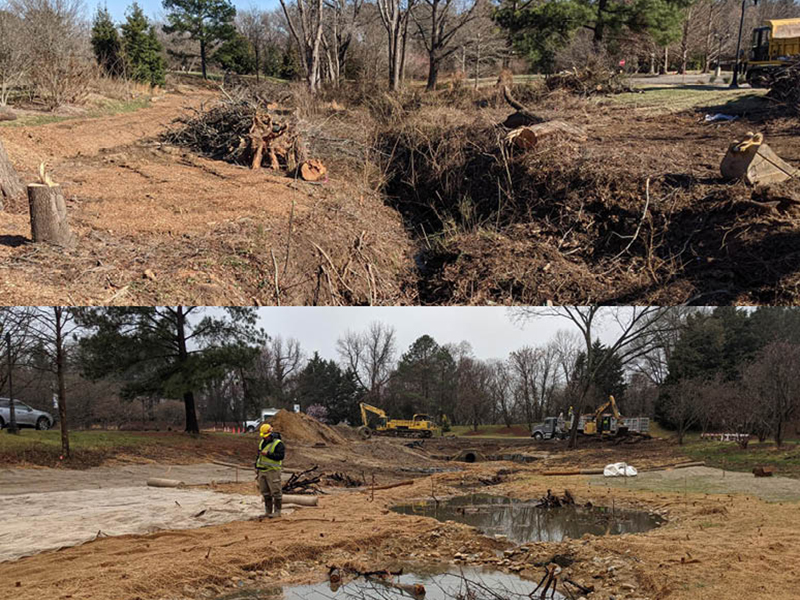
With funding secured from the Virginia Environmental Endowment, the National Fish and Wildlife Foundation, Dominion Energy Foundation, and a private donor, design and permitting were finalized, and the project is now in the final stages of construction! We are supervising the work, which is being done by Meadville Land Service, Inc., and we couldn’t be happier with the way things are looking. For more information about this project, please contact Lee Mallonnee.
Coastal Resilience in Maryland’s Cape St. Claire
As you read this, the shoreline along one Chesapeake Bay community is getting naturally stronger and more resilient. In 2020, concerned about the vulnerability of its beachfront, the Annapolis, Maryland neighborhood of Cape St. Claire turned to Biohabitats for help creating a solution. Located along the Magothy River near its confluence the Bay, the beach had experienced significant erosion that would likely worsen with projected sea-level rise. After assessing and analyzing ecological assets within the 1500-acre neighborhood, we worked with the Cape St. Claire Community Association and the Alliance for the Chesapeake Bay to identify and prioritize opportunities to enhance shoreline and community resilience through ecological restoration and other nature-based solutions. We are delighted to report that several of those opportunities are now realities.
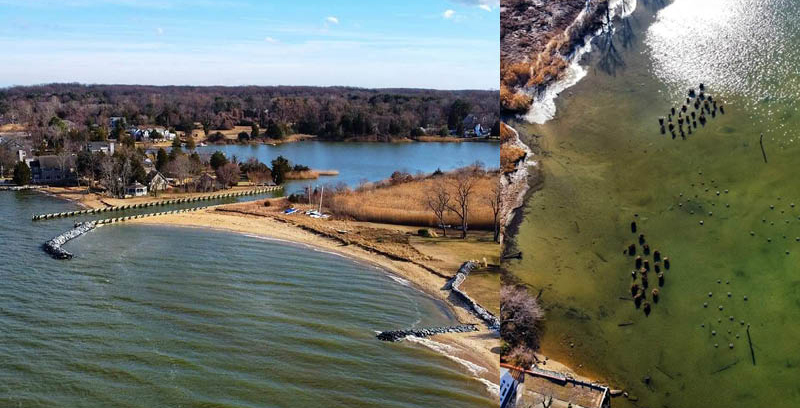
At one site, we dredged 1200-CY of sand from a shoaling navigation channel connecting the Little Magothy River to the Magothy River and used the dredged sand on the community beach to restore the lost beach. We also installed two headland breakwaters, a cobble bar, and a groin to reduce erosion and restore processes that would allow shoreline accretion. We built a battenboard structure on a community pier to accrete sand to restore a second community beach at the western-most end of the Cape St Claire community. At the mouth of a tidal pond, we installed 40 inverted trees with rootwads and 40 reef balls to reduce wave erosion and support sand accretion, while adding habitat complexity. These nature-based solutions are designed to become stronger and more robust over time. For more information about this project, please contact Joe Berg.
Designing the Chandler Mill Road Path: A Segment of the Kennett Greenway Progresses!
Our team is wrapping up final design and engineering with Kennett Township and their regional partners on the first segment on the western side of the Kennett Greenway trail loop after two years of robust community engagement and preliminary engineering studies. Biohabitats continues to facilitate an interdisciplinary design team including McMahon Associates (transportation and trail engineering and design), Unknown Studio (landscape architecture), and Meliora Design (water and stormwater engineering), with ongoing specialized technical support from Lotus Environmental, GHD, and GeoStructures. This initial portion of the Greenway will run along a segment of the West Branch of the Red Clay Creek overlooking native riparian forest, lush wetlands, and a historic millrace.
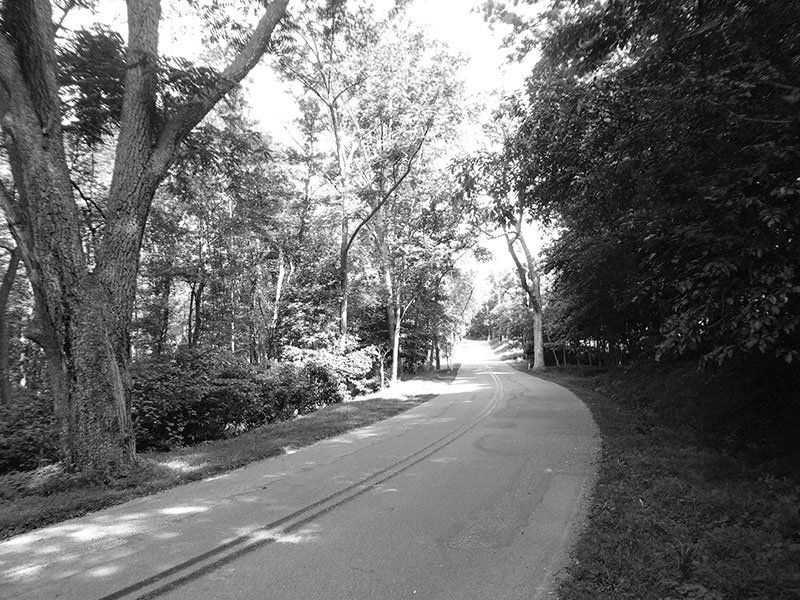
The design features an accessible trail along Chandler Mill Road, native riparian forest plantings, traffic calming, integrated stormwater management, and enhanced connection to the Land Conservancy for Southern Chester County at the Chandler Mill Nature Preserve. For more information about this project, please contact Jennifer Dowdell.
PLACES
Biohabitats’ Tanaira Cullens at SXSW
Every March people from all over the world gather in Austin, Texas to celebrate and share music, film, technology, and innovative ideas worth spreading. The event, South by Southwest (SXSW), draws hundreds of thousands of attendees and features performances, exhibits, screenings, and talks by innovators. Among this year’s featured presenters was Biohabitats environmental scientist, Tanaira Cullens. Tanaira and Niamh McQuillan from Baltimore County Public Schools took the stage on March 16 to present “Now + How: Climate Revolution at your Doorstep.” They discussed ways to leverage community power and host successful forms, as they have done with the Baltimore Blue Green Just, a coalition that actively advocates for new approaches to address environmental and social justice issues in Baltimore.
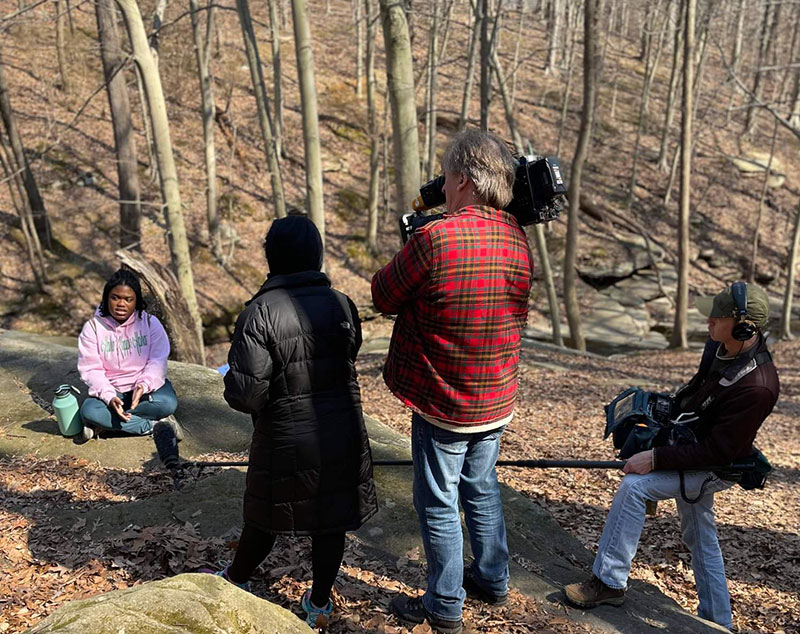
Tanaira’s work, volunteer initiatives, and participation in SXSW caught the attention of German national public television broadcaster, ZDF. ZDF crews not only filmed Tanaira at SXSW but visited her in Baltimore while she hosted a group of volunteers at a tree planting organized by Friends of Herring Run Park and them took them out for some forest bathing afterwards. ZDF will feature Tanaira in an episode of a magazine-style show that will feature young people who are bringing innovation and creative thinking to the climate crisis. We are thrilled to see Tanaira on the global stage, and we’ll be sure to share information about that episode in the future!
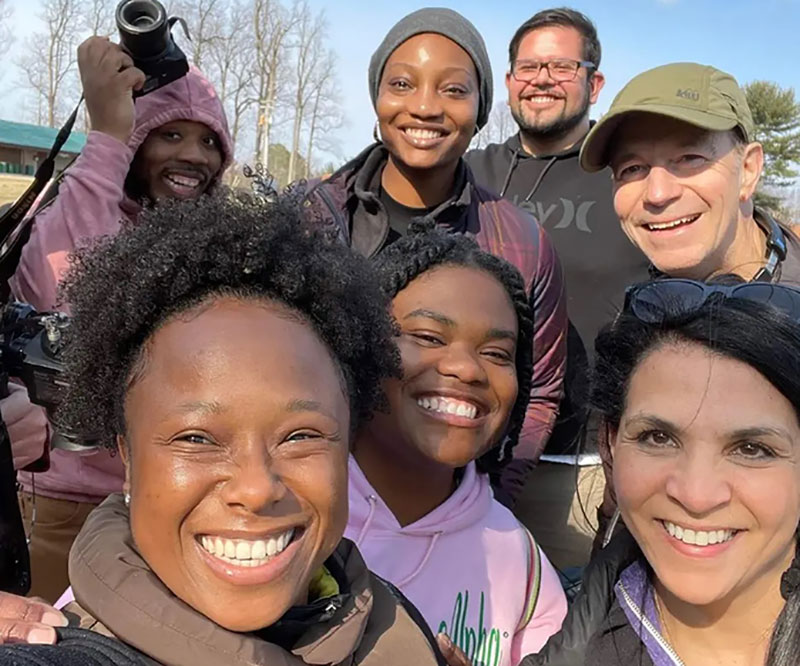
The North American Chapter of the International Association of Landscape Ecologists will hold its annual meeting virtually April 11-13. On April 12, Senior Landscape Ecological Planner and Designer Jennifer Dowdell will be framing discussions, facilitating dialogue between speakers, and managing Q&A portions of an afternoon-long symposium on “Building inclusive and just practices for citizen science in the landscape.”
The 2022 Annual Meeting of the SER Midwest-Great Lakes Chapter is being held virtually on March 23, 25, 28, and in-person from April 1 to April 3. On April 2, Landscape Ecologist Kevin Grieser and Senior Ecological Designer Suzanne Hoehne will present “From Farmland to Wetlands, Restoration at the Redhorse Bend Preserve.”
The International Living Future Institute will hold its annual conference virtually from May 2-13. Living Future 22 carries the theme of “Restoration + Justice”. Biohabitats Integrated Design Specialist, Juan Rovalo will be presenting a talk.
This year’s Ohio Stormwater Conference will take place in Sandusky, Ohio May 11-13 and virtually on May 15. Landscape ecologist Kevin Grieser and Senior Ecological Designer Suzanne Hoehne will present “From Farmland to Wetlands, Restoration at the Redhorse Bend Preserve.”
The annual meeting of the North Carolina chapter of ASLA will take place May 19-21 in Wilmington, NC. On May 20, Senior Landscape Architect Jim Cooper will join Andropogon Associates’ Martha Eberle to present “From Prison to Preserve: Building Ecological Health and Resiliency within the North Carolina Museum of Art Park.”
Tom Denbow and Kevin Grieser from Biohabitats Great Lakes Bioregion office will be in Muskegon, MI May 24-26 to attend the annual Great Lakes Areas of Concern Conference, which is presented by the Michigan Department of Environment, Great Lakes, and Energy (EGLE), in partnership with the U.S. EPA.
People
Meet Biohabitats’ newest team members
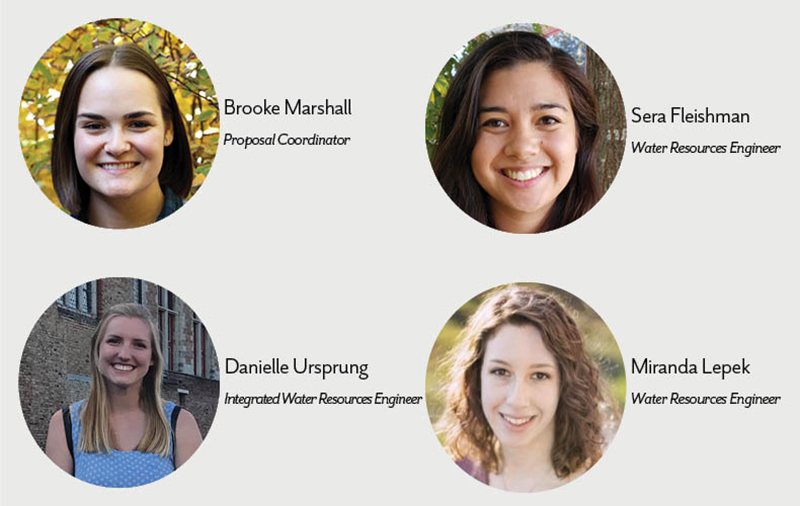
Say hello to Brooke Marshall, Danielle Ursprung, and Sera Fleishman. Can you guess which one of these new team members likes to hang out with her chickens when she needs to relieve stress? Or which one dreamt of being a singer/songwriter as a child? Learn more about our newest Biohabitants on our Rhizome blog!

Award-Winning Team Members
Biohabitats’ quarterly Golden Acorn award is presented to a team member who has excelled in demonstrating our mission to “Restore the Earth and Inspire Ecological Stewardship.” The gold color symbolizes purity of purpose in protecting and defending nature, and the acorn symbolizes strength of resolve. Golden Acorn winners direct a monetary donation to non-profit organizations of their choice. The most recent winners of the Golden Acorn award were ecological restoration specialist Jacques Varvel from Biohabitats Construction; Katherine Bartter, our People and Culture Leader; and water resources engineer Kevin Dahms from our Hudson River Bioregion office. Jacques directed his donation to Oregon Wild and the Ocean Blue Project. Katherine chose the South Carolina Environmental Law Project (a nonprofit we have featured in a previous issue of Leaf Litter) and the Southern Appalachian Highlands Conservancy as the recipients of her Golden Acorn donation. Kevin’s donation will go to Groundwork Bridgeport and Groundwork Hudson Valley. Congratulations to Jacques, Katherine, and Kevin!
